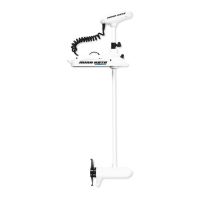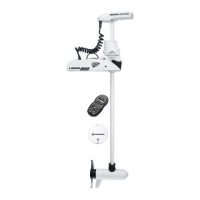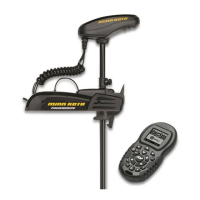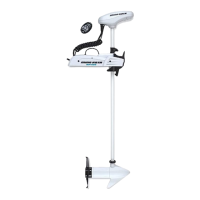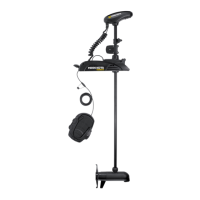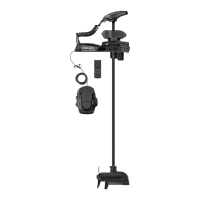with motors that include a bonding wire.
Additional Accessories Connected to Trolling Motor Batteries
Significant damage to your Minn Kota motor, your boat electronics, and your boat can occur if incorrect connections are made between your trolling motor batteries and
other battery systems. Minn Kota recommends using an exclusive battery system for your trolling motor. Where possible, accessories should be connected to a separate
battery system. Radios and sonar units should not be connected to any trolling motor battery systems as interference from the trolling motor is unavoidable. If connecting
any additional accessories to any trolling motor battery system, or making connections between the trolling motor batteries and other battery systems on the boat, be sure
to carefully observe the information below.
CONNECTING THE BATTERIES
The negative (-) connection must be connected to the negative terminal of the same battery that the trolling motor negative lead connects to. In the diagrams below this
battery s labeled “Low Side” Battery. Connecting to any other trolling motor battery will input positive voltage into the “ground” of that accessory, which can cause excess
corrosion. Any damage caused by incorrect connections between battery systems will not be covered under warranty.
Automatic Jump Start Systems and Selector Switches
Automatic jump start systems and selector switches tie the negatives of the connected batteries together. Connecting these systems to the “High Side” Battery or
“Middle” Battery in the diagrams below and will cause significant damage to your trolling motor and electronics. The only trolling motor battery that is safe to connect to
one of these systems is the “Low Side” Battery.
NOTICE: The internal bonding wire is equipped with a 3 amp fuse. Improper connections described above carrying in excess of 3 amps will blow this fuse and no further
damage will be exhibited. If this occurs, RF interference from the trolling motor affecting sonar units and other electronics will be more significant. If the fuse is blown the
wiring error should be found and addressed prior to replacing the fuse. The replacement fuse should be 3 amps or less. An intact fuse does not imply correct rigging;
significant
damage can be done by incorrect wiring without approaching 3 amps of current.
12 Volt Systems
1. Make sure that the motor is switched off (speed selector on “OFF” or “0”).
2. Connect positive ( + ) red lead to positive ( + ) battery terminal.
3. Connect negative ( – ) black lead to negative ( – ) battery terminal
WARNING
For safety reasons do not switch the motor on until the propeller is in the water. If installing a lead wire plug, observe proper polarity and follow instructions in your boat
owner’s manual.
WARNING
For safety reasons, disconnect the motor from the battery or batteries when the motor is not in use or while the battery/batteries are being charged.
Improper wiring of 24/36 volt systems could cause battery explosion.
Keep lead wire wing nut connections tight and solid to battery terminals.
Locate the battery in a ventilated compartment.
CONNECTING THE BATTERIES IN SERIES
CONNECTING THE BATTERIES IN SERIES (IF REQUIRED FOR YOUR MOTOR)
24 Volt Systems
Two 12 volt batteries are required. The batteries must be wired in series, only as directed in a wiring diagram, to provide 24 volts.
1. Make sure that the motor is switched off (speed selector on “0”).
2. Connect a connector cable to the positive ( + ) terminal of battery 1 and to the negative ( – ) terminal of battery 2.
3. Connect positive ( + ) red motor lead to positive ( + ) terminal on battery 2.
4. Connect negative ( – ) black motor lead to negative ( – ) the terminal of battery 1.
WARNING
For safety reasons do not switch the motor on until the propeller is in the water. If installing a lead wire plug, observe proper polarity and follow instructions in your boat
owner’s manual.
WARNING
For safety reasons, disconnect the motor from the battery or batteries when the motor is not in use or while the battery/batteries are being charged.
Improper wiring of 24/36 volt systems could cause battery explosion.
Keep lead wire wing nut connections tight and solid to battery terminals.
Locate the battery in a ventilated compartment.
This completes the installation of your Riptide PowerDrive. A Complete Owner’s Manual can be downloaded at minnkotamotors.com.
RECOMMENDED ACCESSORIES

